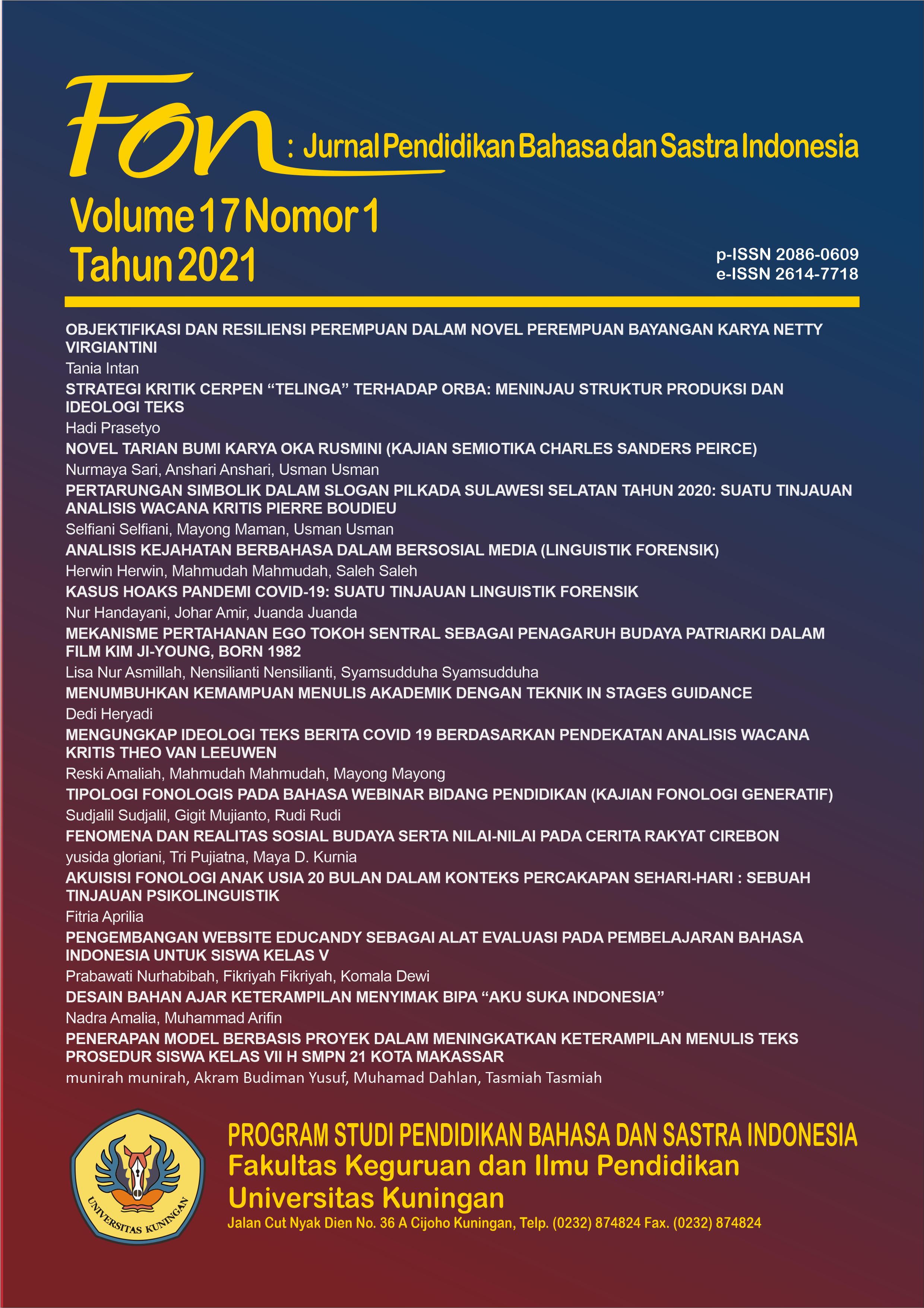TIPOLOGI FONOLOGIS PADA BAHASA WEBINAR BIDANG PENDIDIKAN (KAJIAN FONOLOGI GENERATIF)
Abstrak
ABSTRAK: Dilaksanakannya penelitian melalui pendekatan fonologi generatif ini bertujuan mendeskripsikan proses dan kaidah fonologis bahasa webinar khususnya bidang pendidikan. Metode penelitian yang digunakan deskriptif kualitatif, sedangkan analisis datanya menggunakan model analisis Mile Huberman. Sumber data penelitian ini adalah empat rekaman video webinar. Data penelitian berupa kata yang secara fonetis merepresentasikan tipologi fonologis bahasa webinar. Hasil penelitian ini menunjukkan bahwa proses fonologis meliputi 1) asimilasi bertipe regresif, total, parsial, dan langsung, 2) pelemahan bunyi bertipe aferesis, sinkop, dan apokop, sedangkan penguatan bunyi bertipe protesis, epentesis, paragog, dan peluncuran, 3) netralisasi terjadi pada perubahan fonetis bunyi [b] menjadi bunyi [p], dan bunyi [d] menjadi [t] terjadi pada suku kata akhir (koda), 4) disimilasi terjadi secara langsung yang ditandai berubahnya deret konsonan [jj] menjadi [rj], deret konsonan [tt] menjadi [pt], deret konsonan [rr] menjadi [l], dan deret konsonan [ll] menjadi [j], 5) metatesis terjadi karena perubahan letak bunyi KKV dalam silabel menjadi KVK. Pengaidahan fonologis didasarkan fitur distingtif fonem dan penggunaan notasi fitur distingtif.
KATA KUNCI: bahasa webinar; fonologi generatif; tipologi
>
PHONOLOGICAL TYPOLOGY IN THE WEBINAR LANGUAGE OF EDUCATION (STUDY OF GENERATIVE PHONOLOGY)
ABSTRACT: This current generative phonology study is aimed at describing the processes as well as the phonological patterns of webinar language, specifically in the education field. Descriptive qualitative design was employed; the data analysis was conducted by means of Miles Huberman model. The data were collected from the webinar recordings. Data in the form of words that phonetically represent phonological typologies of webinar language. It has been revealed that the phonological processes include 1) assimilation with the types of regressive, total, partial, and direct; 2) sound attenuation with the types of apheresis, syncope, and apocope; while sound reinforcement is evident by means of prosthesis, epenthesis, paragoge, and gliding; 3) neutralization from the sound of [b] into [p], and the sound [d] into [t] in the last syllable (coda); 4) dissimilation that occurs directly demonstrated by the alteration of consonant cluster [jj] into [rj], consonant cluster [tt] into [pt], consonant cluster [rr] into [l], and consonant cluster [ll] into [j]; 5) metathesis occurs due to the alteration of sound position of CCV into CVC in a syllable. Phonological patterns are based on phoneme distinctive features and the use of distinctive feature notation.
KEYWORDS: webinar language; generative phonology; typologiesReferensi
Astini, N. K. S. (2020). Tantangan Dan Peluang Pemanfaatan Teknologi Informasi Dalam Pembelajaran Online Masa Covid-19. Cetta: Jurnal Ilmu Pendidikan, 3(2), 241–255.
Chomsky, N. (1972). Language and Mind. New York: Harcourt Brace.
Dani, J. A., & Mediantara, Y. (2020). Covid-19 Dan Perubahan Komunikasi Sosial. Persepsi, 3(1), 94–102.
Kenstowicz, M., & Kissenbert, C. (1979). Generative Phonology: Descriptive and Theory. New York: Academic Press. Inc.
Kridalaksana, H. (1986). Pengembangan Ilmu Bahasa dan Pembinaan Bangsa. Ende-Flores: Penerbit Nusa Indah.
Lyons, J. (1984). Language and Linguistics. London: Cambridge University Press.
Nafisah, S. (2017). Proses Fonologis dan Pengkaidahannya dalam Kajian Fonologi Generatif. Deiksis, 9(1), 70–78.
Sakri, A. (1993). Ilmuwan dan Bahasa Indonesia. Bandung: Penerbit ITB.
Schane, S. A. (1973). Generative Phonology. New Jersey: Prentice Halle.
Sela, A. W., & Nurhayati, N. (2020). Proses Asimilasi pada Bahasa Sumbawa: Fonologi Generatif. Parafrase, 20(1), 9–13.
Setiana, L. N., Supriyatno, T., & Rahayu, P. (2021). Inovasi Pembelajaran Bahasa Indonesia Daring Berbasis Mini Webinar. Metamorfosa, 9(1), 1–13.
Suparno. (2002). Dasar-dasar Linguistik Umum. Yogyakarta: Tiara Wacana.
Tarmini, W., Safi’i, I., Witdianti, Y., & Larassaty, S. (2020). Peningkatan Kompetensi Profesional Guru Melalui Webinar Evaluasi Hasil Belajar Bagi Guru-Guru Mts. Al-Ma’arif 1 Aimas. Transformasi: Jurnal Pengabdian Masyaraka, 16(1), 53–62.
Wahab, A. (2005). Butir-Butir Linguistik. Surabaya: Air Langga University Press.
Wibowo, B. R., Sudan, D., & Wirza, Y. (2020). Pemanfaatan Webinar Sebagai Media dalam Pembelajaran Kemampuan Berbicara untuk Pembelajar Dewasa di Indonesia. Jurnal Penelitian Pendidikan, 20(3), 417–431.
Yule, G. (1996). Pragmatics. New York: OUP Oxford.
Yulianto, B. (2019). Teori dan Aplikasi Fonologi Generatif. Gersik: Graniti.
##submission.copyrightStatement##
##submission.license.cc.by-sa4.footer##Penulis yang menerbitkan artikel dalam Fon: Jurnal Pendidikan Bahasa dan Sastra menyetujui persyaratan berikut:
- Penulis memiliki hak cipta artikel dan memberikan hak jurnal untuk publikasi pertama dengan karya yang secara simultan dilisensikan di bawah lisensi CC-BY-SA atau The Creative Commons Attribution - Share Alike Licence.
- Penulis dapat mengadakan perjanjian kontrak tambahan yang terpisah untuk distribusi non-eksklusif versi jurnal yang diterbitkan dari karya tersebut (misalnya, mempostingnya ke repositori institusional atau menerbitkannya dalam sebuah buku), dengan pengakuan atas publikasi awalnya di jurnal ini.
- Penulis diizinkan dan didorong untuk memposting pekerjaan mereka secara online (mis., Dalam repositori institusional atau di situs web mereka) sebelum dan selama proses pengajuan, karena dapat menyebabkan pertukaran yang produktif, serta kutipan yang lebih awal dan lebih besar dari karya yang diterbitkan.


